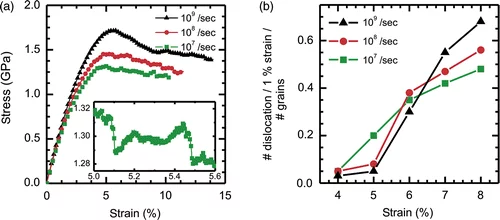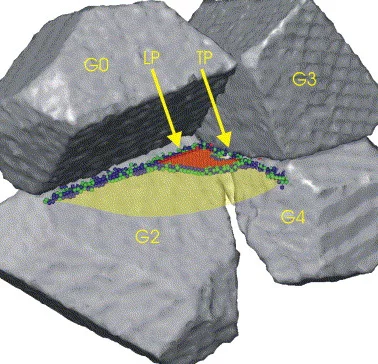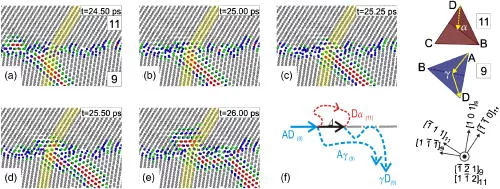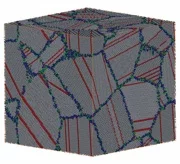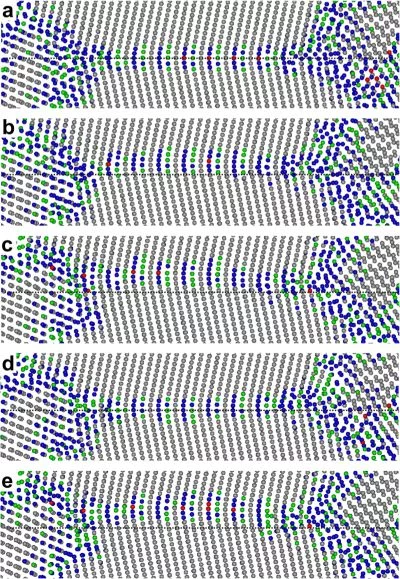Emission of a vacancy inside the grain after unpinning of the dislocation dipole (CA,AC). The atoms are coloured based on the Common Neighbor Analysis (CNA), where face centred cubic (FCC) atoms, hexagonal close-packed (HCP) atoms and other coordinated atoms are coloured in grey, red, and blue, respectively. The purple circled region shows the formation of a vacancy, from a point defect dragged at the jog resulting from the interaction of the two dislocations.
Dislocation Interactions in nanocrystalline Al at reduced strain rates
Inspired by the transient testing experiments we carried out molecular dynamics simulations of stress drops in the regimes similar to those experimentally performed, with the aim to explore the mechanisms responsible for GB accommodation and to verify whether dislocations are still emitted when strain rates after the stress drops are up to 2 or 3 orders of magnitude lower than those usually applied in atomistic deformation simulations. Our approach reveals that at these lower strain rates, GB accommodation processes are enhanced and dislocations are observed to slip on planes experiencing relatively low resolved shear stress. Additionally, a new GB-dislocation interaction mechanism is evidenced, where the misfit regions available at the GB assist the propagation of a lattice dislocation on a plane with low resolved shear stress. Furthermore, it is shown that the interaction of two dislocations gliding on parallel slip planes can result in the emission of a vacancy in the grain interior. For similar strains obtained with a strain rate of 1e8/s strain rate as usually applied in MD, both mechanisms are not observed and dislocations slip preferentially on high Schmid factor planes.
Dislocation interactions at reduced strain rates in atomistic simulations of nanocrystalline Al
Dupraz M, Zhen S, Brandl C, Van Swygenhoven H
Acta Materiala, Accepted
Dislocation interactions at reduced strain rates in atomistic simulations of nanocrystalline Al
Dupraz M, Zhen S, Brandl C, Van Swygenhoven H
Acta Materiala, Accepted
(a) Stress-strain curve for three different constant strain rates at 300K temperature. Inset shows a close up of the stress-strain curve for 1 e7/sec showing the discrete stress drops associated with individual dislocation propagation within grains. (b) The number of dislocation propagation per 1% strain increment as a function of strain for all three strain rates normalized by the number of grains (100).
The effect of strain rate in molecular dynamics
To study deformation mechanisms using molecular dynamics, very high strain rates have to be applied. The effect of lowering the strain rate by two orders of magnitude on the deformation characteristics of nanocrystalline Al was investigated. For the highest strain rate, the onset of dislocation propagation is delayed, resulting in a stress overshoot. With decreasing strain rate the grain-averaged resolved shear stress reduces and cross-slip occurs more frequently. However, even at the lowest applied strain rate the grain boundary network can not accommodate all arriving dislocations, illustrating the challenge to determine the rate-limiting deformation mechanisms for experimental conditions.
Strain rates in molecular dynamics simulations of nanocrystalline metals
Brandl C, Derlet P M, Van Swygenhoven H
Philosophical Magazine 89, 3465-3475 (2009)
Strain rates in molecular dynamics simulations of nanocrystalline metals
Brandl C, Derlet P M, Van Swygenhoven H
Philosophical Magazine 89, 3465-3475 (2009)
(left) Three-dimensional environment of surrounding GB structure. Non-fcc atoms of the atomic section considered are shown visualising the GB region and the nucleation of the leading partial (LP) and trailing partial (TP) connected via a (111) SF defect. (right) Example for the unpinning of a preexisting partial dislocation loop, combined with the nucleation of the trailing partial dislocation. (a–c) Show a cut through the grain with the atoms colored according to their local crystallographic order. The grain-averaged shear in that grain is shown in (d) by the green line, the blue line shows the resolved shear stress on the slipping dislocation.
Dislocation nucleation and propagation in nc environment
Detailed analysis of the nucleation and propagation of dislocations from grain boundaries in nanocrystalline Al using molecular dynamics reveals that: (1) the leading and trailing partial dislocations are nucleated at different regions within a grain boundary or even different grain boundaries; (2) propagation is hindered by a pinning–depinning mechanism influenced by the relative orientation between the Burgers vector and the ledge geometry of the grain boundary and (3) depinning is thermally activated and therefore not purely mechanically driven. Detailed analysis of the atomic processes allowed correlation of the stress signature of slip events with typical dislocation processes related to nucleation and propagation.
Nucleation and propagation of dislocations in nanocrystalline fcc metals
Bitzek E, Derlet P M, Anderson P M, Van Swygenhoven H
Acta Materialia 56, 4846-4857 (2008)
Nucleation and propagation of dislocations in nanocrystalline fcc metals
Van Swygenhoven H, Derlet P M, Frøseth A G
Acta Materialia 54, 1975-1983 (2006)
Nucleation and propagation of dislocations in nanocrystalline fcc metals
Bitzek E, Derlet P M, Anderson P M, Van Swygenhoven H
Acta Materialia 56, 4846-4857 (2008)
Nucleation and propagation of dislocations in nanocrystalline fcc metals
Van Swygenhoven H, Derlet P M, Frøseth A G
Acta Materialia 54, 1975-1983 (2006)
Generalized stacking fault energy and nature of slip
Using molecular dynamics simulations, the nature of slip in nanocrystalline metals cannot be described in terms of the absolute value of the stacking fault energy—a correct interpretation requires the generalized stacking fault energy curve, involving both stable and unstable stacking fault energies.
In conclusion, whether the dislocation activity in a simulation is dominated by extended partials or full dislocations travelling through the grains in the simulated time span must be understood in terms of the ratio γsf/γusf. Similarly, the observation of twin nucleation via an extended partial on an adjacent plane is dependent on the ratio γutf/γusf. To understand the slip activity observed in simulations, all aspects of the GPF curve have to be incorporated, and not just the absolute value of γsf.
General-stacking-fault energies in highly strained metallic environments: Ab initio calculations
Brandl C, Derlet P M, Van Swygenhoven H
Physical Review B 76, 054124 (2007)
Stacking fault energies and slip in nanocrystalline metals
Van Swygenhoven H, Derlet P M, Frøseth A G
Nature Materials 3, 399-403, (2004)
General-stacking-fault energies in highly strained metallic environments: Ab initio calculations
Brandl C, Derlet P M, Van Swygenhoven H
Physical Review B 76, 054124 (2007)
Stacking fault energies and slip in nanocrystalline metals
Van Swygenhoven H, Derlet P M, Frøseth A G
Nature Materials 3, 399-403, (2004)
Dislocation cross-slip
Constant strain rate molecular dynamics simulations of nanocrystalline Al demonstrate that a significant amount of dislocations that have nucleated at the grain boundaries, exhibit cross-slip via the Fleischer mechanism as they propagate through the grain. The grain boundary structure is found to strongly influence when and where cross-slip occurs, allowing the dislocation to avoid local stress concentrations that otherwise can act as strong pinning sites for dislocation propagation.
Dislocation Cross-Slip in Nanocrystalline fcc Metals
Bitzek E, Brandl C, Derlet P M, Van Swygenhoven H
Physical Review Letters 100, 235501 (2008)
Dislocation Cross-Slip in Nanocrystalline fcc Metals
Bitzek E, Brandl C, Derlet P M, Van Swygenhoven H
Physical Review Letters 100, 235501 (2008)
Dislocation transmission trough a general grain boundary
The atomistic simulation reveals that the regions of misfit act as strong pinning centers for the newly created dislocation. Furthermore, the simulations lead us to the assumption that the choice of the Burgers vector of the outgoing dislocation is not only influenced by the resolved shear stress of the outgoing slip system, but also by its influence on the local atomic structure of the grain boundary.
Slip transfer through a general high angle grain boundary in nanocrystalline aluminum
Brandl C, Bitzek E, Derlet P M, Van Swygenhoven H
Applied Physics Letters 91, 111914 (2007)
Slip transfer through a general high angle grain boundary in nanocrystalline aluminum
Brandl C, Bitzek E, Derlet P M, Van Swygenhoven H
Applied Physics Letters 91, 111914 (2007)
The influence of twins on the mechanical properties of nc-Al
It was shown that the influence of the presence of grown-in twin boundaries in nc Cu and Ni is different from the case of nc-Al and can be explained by the values of the extrema of the Generalized Planar Fault energy curves. For Cu and Ni, where the energy barrier for twin migration is not so different from that for nucleation of a single partial dislocation, twin boundary migration does not become dominant over the usual dislocation activity from grain boundaries. Earlier work has shown that for Al, a material where the energy barrier for twin boundary migration is close to a factor of three lower then for the emission of a partial dislocation on a non-adjacent plane, twin boundary migration will become dominant, especially when twin planes are along orientations with a high Schmid factors.
Twinning in Nanocrystalline fcc Metals
Frøseth A G, Derlet P M, Van Swygenhoven H
Advanced engineering materials 7 16-20 (2005)
The influence of twins on the mechanical properties of nc-Al
Frøseth A G, Derlet P M, Van Swygenhoven H
Acta Materialia 52, 2259-2268 (2004)
Grown-in twin boundaries affecting deformation mechanisms in nc-metals
Frøseth A G, Derlet P M, Van Swygenhoven H
Applied Physics Letters 85, 5863 (2004)
Twinning in Nanocrystalline fcc Metals
Frøseth A G, Derlet P M, Van Swygenhoven H
Advanced engineering materials 7 16-20 (2005)
The influence of twins on the mechanical properties of nc-Al
Frøseth A G, Derlet P M, Van Swygenhoven H
Acta Materialia 52, 2259-2268 (2004)
Grown-in twin boundaries affecting deformation mechanisms in nc-metals
Frøseth A G, Derlet P M, Van Swygenhoven H
Applied Physics Letters 85, 5863 (2004)
Grain boundary migration in nanocrystalline environment
Coupled grain boundary motion was simulated in a three-dimensional nanocrystalline Al grain boundary network using molecular dynamics. It is shown that, in spite of the triple junction constraints, a symmetrical R75 tilt boundary can migrate during the microplastic regime with the same coupling factor as when simulated in a bicrystal configuration. After reaching the full plastic regime, dislocations start coming into play, changing the grain boundary structure and hindering further coupled motion.
The simulated Ni sample contained over 2 million atoms arranged in 200 grains of 5 nm average size. Grain boundary migration occurs in conjunction with dislocation emission, it is however not clear if dislocation emission is a necessary condition for grain boundary motion in this configuration.. In experimental work, it is often difficult to distinguish between purely stress driven grain boundary motion and thermal effects. The present simulations help resolve this controversy, since in our simulations the temperature is maintained at 300 K and the deformation process occurs at a very fast strain rate, with limited time for thermally activated motion. Our results indicate that stress driven grain boundary migration is one of the ways in which plasticity can be accommodated by grain boundaries in a 3D nanocrystalline GB network.
Grain boundary migration during room temperature deformation of nanocrystalline Ni
Farkas D, Frøseth A , Van Swygenhoven H
Scripta Materialia 55, 695-698 (2006)
Coupled grain boundary motion in a nanocrystalline grain boundary network
Velascoa M, Van Swygenhoven H, Brandl C
Scripta Materialia 65, 151-154 (2011)
The simulated Ni sample contained over 2 million atoms arranged in 200 grains of 5 nm average size. Grain boundary migration occurs in conjunction with dislocation emission, it is however not clear if dislocation emission is a necessary condition for grain boundary motion in this configuration.. In experimental work, it is often difficult to distinguish between purely stress driven grain boundary motion and thermal effects. The present simulations help resolve this controversy, since in our simulations the temperature is maintained at 300 K and the deformation process occurs at a very fast strain rate, with limited time for thermally activated motion. Our results indicate that stress driven grain boundary migration is one of the ways in which plasticity can be accommodated by grain boundaries in a 3D nanocrystalline GB network.
Grain boundary migration during room temperature deformation of nanocrystalline Ni
Farkas D, Frøseth A , Van Swygenhoven H
Scripta Materialia 55, 695-698 (2006)
Coupled grain boundary motion in a nanocrystalline grain boundary network
Velascoa M, Van Swygenhoven H, Brandl C
Scripta Materialia 65, 151-154 (2011)
The influence of Oxygen in GB migration
One of the important differences between simulation and experiments in grain boundary (GB)-dominated metallic structures is the lack of impurities such as oxygen in computational samples. A modified variable-charge method is used to study coupled GB motion in an Al bicrystal with a [112] symmetrical tilt GB in the presence of substitutional O, and compared with the stick–slip process identified in pure configurations. It is found that the critical shear stress for migration of the GB increases linearly with the number of O atoms. These observations are then rationalized in terms of the internal stress signature of the O atoms in the vicinity of the boundary.
Variable-charge method applied to study coupled grain boundary migration in the presence of oxygen Elsener A, Politano O, Derlet P M, Van Swygenhoven H Acta Materialia 57, 1988-2001 (2009)
A local chemical potential approach within the variable charge method formalism
Elsener A, Politano O, Derlet P M, Van Swygenhoven H
Modelling and Simulation in Materials Science and Engineering 16, 025006 (2008)
Variable-charge method applied to study coupled grain boundary migration in the presence of oxygen Elsener A, Politano O, Derlet P M, Van Swygenhoven H Acta Materialia 57, 1988-2001 (2009)
A local chemical potential approach within the variable charge method formalism
Elsener A, Politano O, Derlet P M, Van Swygenhoven H
Modelling and Simulation in Materials Science and Engineering 16, 025006 (2008)

